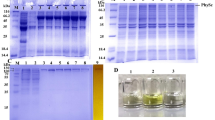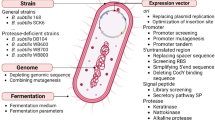Abstract
A copper-inducible laccase activity was detected in Thermus thermophilus HB27. The enzyme was partially purified and separated by SDS-PAGE. After staining, a gel slice containing a ~53-kDa protein was excised and treated with trypsin, and the in-gel digests were analyzed by mass spectrometry. By mass fingerprinting, the peptides were found to share identity with the TTC1370 protein of the thermophile, which was tentatively annotated as a laccase in the whole genome analysis, albeit experimental evidence was lacking. The assigned mass nearest to the N-terminal sequence was that from Gln23 to Lys31. By signal peptide prediction, TTC1370 protein was assumed to be a secretory protein starting from Gln23. The DNA encoding the mature protein was then cloned and expressed in Escherichia coli. The recombinant enzyme, expressed as an apoprotein, was dialyzed against copper-containing buffer to yield a holoprotein. The holoprotein was purified to homogeneity, which displayed a blue color typical of laccases and oxidized canonical laccase substrates such as guaiacol and 2,2′-azino-bis(3-ethylbenzthiazoline-6-sulfonate). The enzyme was most notable for its striking thermophilicity; the optimal reaction temperature was ~92°C and the half-life of thermal inactivation at 80°C was >14 h, ranking it as the most thermophilic laccase reported thus far.







Similar content being viewed by others
Abbreviations
- ABTS:
-
2,2′-Azino-bis(3-ethylbenzthiazoline-6-sulfonate)
- MALDI-TOF MS:
-
Matrix-assisted laser desorption ionization time-of-flight mass spectrometry
- SGZ:
-
Syringaldazine
- Tth-laccase:
-
Laccase from Thermus thermophilus HB27
References
Alexandre G, Zhulin IB (2000) Laccases are widespread in bacteria. Trends Biotechnol 18:41–42
Altschul SF, Gish W, Miller W, Myers EW, Lipman DJ (1990) Basic local alignment search tool. J Mol Biol 215:403–410
Bendtsen JD, Nielsen H, von Heijne G, Brunak S (2004) Improved prediction of signal peptides: SignalP 3.0. J Mol Biol 340:783–795
Britton HTS (1952) Hydrogen ions, 4th edn. Chapman and Hall, London
Claus H (2003) Laccases and their occurrence in prokaryotes. Arch Microbiol 179:145–150
Claus H (2004) Laccases: structure, reactions, distribution. Micron 35:93–96
Claus H, Faber G, Konig H (2002) Redox-mediated decolorization of synthetic dyes by fungal laccases. Appl Microbiol Biotechnol 59:672–678
Clauser KR, Baker PR, Burlingame AL (1999) Role of accurate mass measurement (±10 ppm) in protein identification strategies employing MS or MS/MS and database searching. Anal Chem 71:2871–2882
Deckert G, Warren PV, Gaasterland T, Young WG, Lenox AL, Graham DE, Overbeek R, Snead MA, Keller M, Aujay M, Huber R, Feldman RA, Short JM, Olson GJ, Swanson RV (1998) The complete genome of the hyperthermophilic bacterium Aquifex aeolicus. Nature 392:353–358
DeLisa MP, Lee P, Palmer T, Georgiou G (2004) Phage shock protein PspA of Escherichia coli relieves saturation of protein export via the Tat pathway. J Bacteriol 186:366–373
Fitz-Gibbon ST, Ladner H, Kim UJ, Stetter KO, Simon MI, Miller JH (2002) Genome sequence of the hyperthermophilic crenarchaeon Pyrobaculum aerophilum. Proc Natl Acad Sci USA 99:984–989
Galhaup C, Haltrich D (2001) Enhanced formation of laccase activity by the white-rot fungus Trametes pubescens in the presence of copper. Appl Microbiol Biotechnol 56:225–232
Gasteiger E, Gattiker A, Hoogland C, Ivanyi I, Appel RD, Bairoch A (2003) ExPASy: the proteomics server for in-depth protein knowledge and analysis. Nucleic Acids Res 31:3784–3788
Gill SC, von Hippel PH (1989) Calculation of protein extinction coefficients from amino acid sequence data. Anal Biochem 182:319–326
Henne A, Bruggemann H, Raasch C, Wiezer A, Hartsch T, Liesegang H, Johann A, Lienard T, Gohl O, Martinez-Arias R, Jacobi C, Starkuviene V, Schlenczeck S, Dencker S, Huber R, Klenk HP, Kramer W, Merkl R, Gottschalk G, Fritz HJ (2004) The genome sequence of the extreme thermophile Thermus thermophilus. Nat Biotechnol 22:547–553
Hullo MF, Moszer I, Danchin A, Martin-Verstraete I (2001) CotA of Bacillus subtilis is a copper-dependent laccase. J Bacteriol 183:5426–5430
Huttermann A, Mai C, Kharazipour A (2001) Modification of lignin for the production of new compounded materials. Appl Microbiol Biotechnol 55:387–394
Ikai A (1980) Thermostability and aliphatic index of globular proteins. J Biochem 88:1895–1898
Lasa I, Berenguer J (1993) Thermophilic enzymes and their biotechnological potential. Microbiologia 9:77–89
Martins LO, Soares CM, Pereira MM, Teixeira M, Costa T, Jones GH, Henriques AO (2002) Molecular and biochemical characterization of a highly stable bacterial laccase that occurs as a structural component of the Bacillus subtilis endospore coat. J Biol Chem 277:18849–18859
Mayer AM, Staples RC (2002) Laccase: new functions for an old enzyme. Phytochemistry 60:551–565
Murugesan K (2003) Bioremediation of paper and pulp mill effluents. Indian J Exp Biol 41:1239–1248
Oshima T, Imahori K (1974) Description of Thermus thermophilus (Yoshida and Oshima) comb. nov., a nonsporulating thermophilic bacterium from a Japanese thermal spa. Int J Syst Bacteriol 24:102–112
Outten FW, Huffman DL, Hale JA, O‘Halloran TV (2001) The independent cue and cus systems confer copper tolerance during aerobic and anaerobic growth in Escherichia coli. J Biol Chem 276:30670–30677
Palonen H, Viikari L (2004) Role of oxidative enzymatic treatments on enzymatic hydrolysis of softwood. Biotechnol Bioeng 86:550–557
Peter MG, Wollenberger U (1997) Phenol-oxidizing enzymes: mechanisms and applications in biosensors. EXS 80:63–82
Roberts SA, Wildner GF, Grass G, Weichsel A, Ambrus A, Rensing C, Montfort WR (2003) A labile regulatory copper ion lies near the T1 copper site in the multicopper oxidase CueO. J Biol Chem 278:31958–31963
Sargent F, Bogsch EG, Stanley NR, Wexler M, Robinson C, Berks BC, Palmer T (1998) Overlapping functions of components of a bacterial Sec-independent protein export pathway. EMBO J 17:3640–3650
Skoog B, Wichman A (1986) Calculation of the isoelectric points of polypeptides from the amino acid composition. Trends Anal Chem 5:82–83
Solano F, Lucas-Elio P, Lopez-Serrano D, Fernandez E, Sanchez-Amat A (2001) Dimethoxyphenol oxidase activity of different microbial blue multicopper proteins. FEMS Microbiol Lett 204:175–181
Studier FW, Moffatt BA (1986) Use of bacteriophage T7 RNA polymerase to direct selective high-level expression of cloned genes. J Mol Biol 189:113–130
Suzuki Y, Oishi K, Nakano H, Nagayama T (1987) A strong correlation between the increase in number of proline residues and the rise in thermostability of 5 Bacillus oligo-1,6-glucosidases. Appl Microbiol Biotechnol 26:546–551
Suzuki T, Endo K, Ito M, Tsujibo H, Miyamoto K, Inamori Y (2003) A thermostable laccase from Streptomyces lavendulae REN-7: purification, characterization, nucleotide sequence, and expression. Biosci Biotechnol Biochem 67:2167–2175
Thompson JD, Higgins DG, Gibson TJ (1994) CLUSTAL W: improving the sensitivity of progressive multiple sequence alignment through sequence weighting, position-specific gap penalties and weight matrix choice. Nucleic Acids Res 22:4673–4680
Volkl P, Huber R, Drobner E, Rachel R, Burggraf S, Trincone A, Stetter KO (1993) Pyrobaculum aerophilum sp. nov., a novel nitrate-reducing hyperthermophilic archaeum. Appl Environ Microbiol 59:2918–2926
Wesenberg D, Kyriakides I, Agathos SN (2003) White-rot fungi and their enzymes for the treatment of industrial dye effluents. Biotechnol Adv 22:161–187
Author information
Authors and Affiliations
Corresponding author
Additional information
Communicated by K. Horikoshi
Rights and permissions
About this article
Cite this article
Miyazaki, K. A hyperthermophilic laccase from Thermus thermophilus HB27. Extremophiles 9, 415–425 (2005). https://doi.org/10.1007/s00792-005-0458-z
Received:
Accepted:
Published:
Issue Date:
DOI: https://doi.org/10.1007/s00792-005-0458-z




